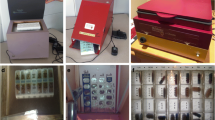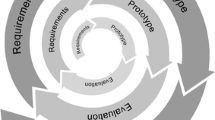Abstract
This paper presents some early design work of the Care in the Digital Community research project begun under the EPSRC IRC Network project Equator. Gaining a comprehensive understanding of user requirements in care settings poses interesting methodological challenges. This paper details some methodological options for working in the domestic domain and documents the translation of research into design recommendations. We report on the importance of medication issues in a hostel for former psychiatric patients and present an early prototype of a medication manager designed to be sensitive to the particular requirements of the setting.
Similar content being viewed by others
References
Anderson R (1994) Representations and requirements: the value of ethnography in system design. Hum Comput Interaction 9:151
Bjørneby S (2000) ‘Smart houses’: can they really benefit older people? Signpost 5(2):pp 36-38
Cheverst K, Cobb S, Hemmings T, Kember S, Friday A, Phillips P, Procter R, Rodden T, Rouncefield M (2001) Design with care. EDRA32 2001, Workshop symposium on adding the user into the design of the home in the digital age, July 2001, Edinburgh
Clarkson PJ, Keates S (2001) A practical inclusive design approach. Proceedings of INCLUDE 2001, London, p 72
Dadong Wan (1999) Magic medicine cabinet: a situated portal for consumer healthcare. In: Proceedings of the first international symposium on handheld and ubiquitous computing (HUC ‘99), 27–29 September 1999, Karlsruhe, Germany, pp 352–355
Dewsbury G, Edge M (2001) Designing the home to meet the needs of tomorrow ...today: smart technology, health and well-being. Open House Int 26(2):33 http://www.smartthinking.ukideas.com/_OHI.pdf
Dewsbury G (2001) The social and psychological aspects of smart home technology within the care sector. New Technol Hum Services 14(1–2):9–18
Edwards K, Grinter R (2001) At home with ubiquitous computing. Proceedings of UbiComp ‘01, Springer, Berlin Heidelberg New York, p 263
Feenberg A (1996) Marcuse or Habermas: two critiques of technology. Inquiry 39:57
Fisk M (2001) The implications of smart home technologies. In: Peace S, Holland C (eds) Inclusive housing in an ageing society. Polity Press, Bristol, UK, p 119
Gaver W (2001) The presence project. Computer Related Design Research Studio, RCA, London
Gaver W, Dunne A, Pacenti E (1999) Cultural probes. Interactions 6(1):21–29
Gaver W, Dunne A, Pacenti E (1999) Design: cultural probes. In: Interactions: new visions of human-computer interaction. ACM, Danvers, MA
Gitlin L (1995) Why older people accept or reject assistive technology. Generations 19(1):43
Hughes JA, King V, Rodden T, Andersen H (1994) Moving out from the control room: ethnography in system design. In: Proceedings of CSCW ‘94, Chapel Hill, NC
Hughes J, O’Brien J, Rodden T (1998) Understanding technology in domestic environments. Proceedings of CoBuild ‘98, Springer, Berlin Heidelberg New York, pp 248–261
Hughes J, O’Brien J, Rodden T, Rouncefield M, Viller S (2000) Patterns of home life: informing design for domestic environments. Personal Technol 4(1):25–38
Lupton D, Seymour W (2000) Technology, selfhood and physical disability. Social Sci Med 50:1852
Mateas M et al. (1996) Engineering ethnography in the home. Proceedings of CHI ‘96, ACM Press, Vancouver, pp 283–284
Microchip (2001) Microchip PIC 16F87X data sheet, 2001. (www.microchip.com)
Mynatt E, Rowan J, Jacobs A, Craighill S (2001) Digital family portraits: providing peace of mind for extended family members. In: Proceedings of the conference on human factors in computing systems (CHI ‘01), Seattle, ACM Press, New York, pp 333–340
O’Brien J, Hughes J, Rodden T, Rouncefield M (1999) At home with the technology. ACM Transactions on computer-human interaction 6(3):282–308
O’Brien J, Rodden T (1997) Interactive systems in domestic environments. Proceedings of DIS ‘97, ACM Press, Amsterdam, pp 247–259
Phillip H (2001) Charge transfer sensing. Quantum Research Group White Paper 2001. (www.qprox.com)
Sacks H (1995) General introduction. In: Jefferson G (ed) Lectures on conversation, part VI, Fall 1967, Blackwell, Oxford, p 621
Sheaff R (1996) The need for healthcare. Routledge, London
The DIRC Project – http://www.dirc.org.uk/
The Equator Project – http://www.equator.ac.uk/. For greater detail on the construction of the medication manager, go to http://www.equator.ac.uk/digicare/
Tweed C, Quigley G (2000) The design and technological feasibility of home systems for the elderly. The Queens University, Belfast
Venkatesh A (1996) Computers and other interactive technologies for the home. Communications of the ACM, 39(12)
Author information
Authors and Affiliations
Rights and permissions
About this article
Cite this article
Cheverst, K., Clarke, K., Dewsbury, G. et al. Designing assistive technologies for medication regimes in care settings. UAIS 2, 235–242 (2003). https://doi.org/10.1007/s10209-003-0055-9
Published:
Issue Date:
DOI: https://doi.org/10.1007/s10209-003-0055-9




